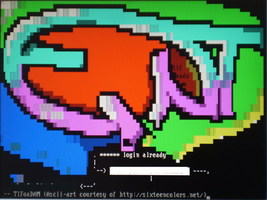

So when you installed libconioh it copied a file, named libconio.la to the /usr/lib directory. a extension and they are stored in /usr/lib/ directory with the name format lib. Gcc file1.c file2.c lib1.a lib2.aIn linux the library files are with. a.outBut what did that -lconio did? See, in gcc the source files and object library files can be linked by specifying them back to back. Gcc myprogram.c -lconioYou will get the a.out file if your program doesn't have any errors. myprogram.c in current working directory) using gcc give the library's detail to the linker like this:
Conio library c install#
Make install Now the library has been installed. Install the library by typing these commands one after another's execution. Now enter into the extracted directory by typingĦ. To make the typing easy you may press the key on your keyboard after typing l of libconio-1.0.0.tar.gz for autocompletion of filename.ĥ. Tar -zxvf libconio-1.0.0.tar.gz and press enter to extract the archive. Open the terminal, by pressing Alt+F2 and typing xterm and pressing enter.
Conio library c archive#
Copy the downloaded archive to your home folderĢ. Here are the steps(I'm considering Ubuntu as the example):ġ.
Conio library c download#
Just download the libconioh from this link I faced the same problem and I ran around like everything to find a soluion. So, you'll miss your header file that you used in Turbo. But since standard library function getchar() buffers the input until ENTER key is pressed, it will be quite irritating for you. Interactive in the sense that you want an action to be performed as soon as a key is pressed. This will be handy for you.Īt some point of time you will write a program in which you want interactive user input from the user. which work perfect in DOS environment with Turbo C.Īfter they learn about linux, and then GCC they start practicing in linux. Also there are other functions like gotoxy() etc. Turbo C has a header file(unspecified in ANSI standard) with which programmer can program for unbuffered input using functions like getch(). Most of the students are taught C/C++ with Turbo C/C++ IDE in schools.
Conio library c how to#
wherex() gives us the X-axis co-ordinate while wherey() gives us the Y-axis co-ordinate.This article will teach you how to use header file while programming in C under linux environment with GCC, and getting unbuffered input from the user. Printf("The position of cursor is changed") This function takes two parameters and takes your cursor on a particular coordinate on the window. Printf("\nThis appears after clearing the screen.") Printf("\nOnly this sentence will be cleared because we are using delline() only once.") Printf("Press any key to stop the process.\n")

It is useful in games to tell whether a user has pressed key or not. Kbhit() tells us if a user has pressed any key or not. They work on values as per the format speficier.

It prints a string of characters on the output screen. It replaces CR/LF with the null terminator (\0) at the end of the string. Combination of both gives us new line(\n) effect.). It reads a string of characters from the console until it encounters carriage-return (CR) and linefeed (LF)( Carriage return points the cursor to the beginning of the line horizontly and Line feed shifts the cursor to the next line vertically. It prints one character on the output screen. It also prints the value of the character we input on the screen. Getche() is similar to getch() but it can input alphanumeric values too. We don’t care about the input here.We want that the window should wait for the user's input to proceed/end the program. It reads one character from the keyboard. Printf("This appears after clearing the screen.") Printf("\nThese two sentences will be cleared.") This function is used to clear the output screen. List of Functions in conio.hįollowing are some of the functions of the header file conio.h. Here, we will use Turbo C to compile our programs. GCC compiler does not support this header file. It contains console input and output functions which are mostly used by MS-DOS compilers. In this tutorial, we will learn about a non-standard but very useful header file in C, conio.h.Ĭonio stands for console input output. Till now, you must have heard a lot about stdio.h header file which is one of the standard header files in C.


 0 kommentar(er)
0 kommentar(er)
